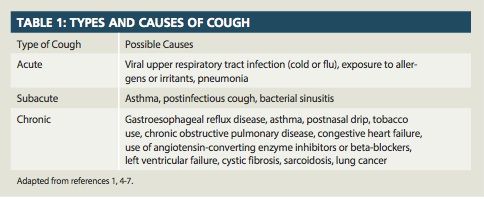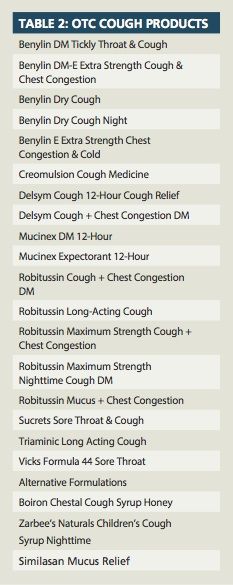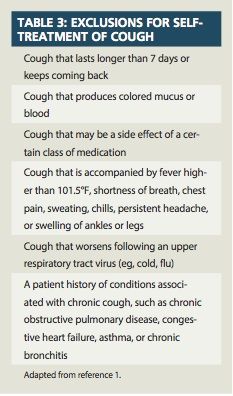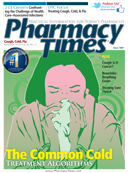Publication
Article
Pharmacy Times
OTC Cough Products: A Quieting Effect
Author(s):
Every year, consumers spend billions of dollars on nonprescription medications for the treatment and management of cough.
Every year, consumers spend billions of dollars on nonprescription medications for the treatment and management of cough.1
Cough can be classified as acute or chronic. Acute cough typically lasts less than 3 weeks, and subacute cough lasts 3 to 8 weeks. Chronic cough, which lasts longer than 8 weeks, is the most common symptom for which patients seek medical care in the ambulatory setting.1,3 Chronic cough is also classified as productive or nonproductive.1 Cough generally results from exposure to irritants or allergens, certain medical conditions, or the use of specific medications (Table 1).1,4-7

Studies have revealed that more than 90% of chronic coughs are due to postnasal drip, asthma, and gastroesophageal reflux disease.7 Although the majority of coughs will resolve on their own, some types (eg, chronic cough) can negatively impact quality of life by interfering with sleep and causing headaches, urinary incontinence, chest pain, or fatigue.1-5
Types of Nonprescription Cough Medications
Nonprescription expectorants and oral and topical antitussives are available in a variety of dosage forms for the treatment and management of cough (Table 2).

Expectorants
Guaifenesin is the only FDA-approved expectorant and is indicated for the symptomatic relief of acute nonproductive cough.1 Guaifenesin is not associated with any known drug—drug interactions and is generally well tolerated, but adverse effects such as nausea, vomiting, and gastrointestinal (GI) upset have been reported.1 Expectorants are available in various forms, including liquids, syrups, granules, tablets, and liquid-filled capsules.
Antitussives
FDA-approved nonprescription oral antitussives include dextromethorphan, diphenhydramine, and codeine.1 The majority of available cough suppressants contain dextromethorphan, which is indicated for the suppression of nonproductive cough caused by chemical or mechanical respiratory tract irritation.1 Dose forms for dextromethorphan include syrups, liquids, suspensions, liquid-filled gel caps, granules, and lozenges. The most common adverse effects associated with dextromethorphan include nausea, vomiting, GI discomfort, dizziness, and constipation.1
Diphenhydramine is classified as a nonselective first-generation antihistamine with significant sedative and anticholinergic properties.1 Although approved by the FDA as an antitussive, diphenhydramine is not considered a first-line treatment.1 It acts centrally on the medulla to increase cough threshold.1 Diphenhydramine is indicated for the suppression of nonproductive cough caused by chemical or mechanical respiratory tract irritation. Camphor and menthol are the only 2 FDA-approved topical antitussives.1 Codeine is classified as a schedule C-V narcotic and is available in many states without a prescription.1 It acts centrally on the medulla to increase the cough threshold. Codeine is indicated for the suppression of nonproductive cough caused by
chemical or mechanical respiratory tract irritation.1 When administered at antitussive doses, codeine has low toxicity and carries little risk for addiction.1
The Pharmacist’s Role
Before recommending any of these products, pharmacists should ascertain whether self-treatment is appropriate and should always screen the patient’s allergy history, medical history, and current medication profile to check for potential drug interactions or contraindications. Pregnant and lactating women and those with chronic medical conditions should always consult their primary health care provider before using any nonprescription medication.
Because cough may be a symptom of many acute and chronic medical conditions, self-treatment may delay identification of the underlying cause and thus proper treatment.1 Individuals with chronic cough should be encouraged to seek a medical evaluation from their primary health care provider, especially if the cause is unknown or if the cough is not improving or is worsening (Table 3).1 In many cases, cough will improve or stop if the underlying cause is treated.1,7 Patient’s whose cough is likely due to the use of certain medications, such as angiotensin-converting enzyme inhibitors, should ask their primary health care provider or pharmacist to recommend a drug class that does not cause cough. Patients with a smoker’s cough should be encouraged to consider smoking cessation programs.

To avoid therapeutic duplication or excessive dosing, patients should be reminded to read labels prior to administration of any medication and to check ingredients, especially if taking multiple products. It is also important that patients adhere to the recommended dosage, administration, and duration of use guidelines. It is particularly critical for parents and caregivers to be reminded to always use calibrated measuring devices when administering liquid medications to children and to read all labels to ensure accurate dosing.
Children should only be given nonprescription products that are manufactured specifically for the pediatric population, and the manufacturer’s recommendations should be followed. When in doubt regarding the appropriateness or dose of a medication, parents and caregivers should consult their pediatrician or pharmacist. The FDA offers excellent resources regarding the use of cough and cold medications in infants and children, including safety concerns and alternative treatment methods.8,9
Ms. Terrie is a clinical pharmacy writer based in Haymarket, Virginia.
References
- Tietze K. Cough. In: Krinsky D, Berardi R, Ferreri S, et al, eds. Handbook of Nonprescription Drugs. 17th ed. Washington, DC: American Pharmacists Association; 2011:205-216.
- Chen HH, Jafek BW. Chronic cough. Medscape website. http://emedicine.medscape.com/article/1048560-overview. Updated May 13, 2014. Accessed October 6, 2014.
- Palombini BC, Villanova CA, Araújo E, et al. A pathogenic triad in chronic cough: asthma, postnasal drip syndrome, and gastroesophageal reflux disease. Chest. 1999;116(2):279-284.
- What causes cough? National Heart, Lung, and Blood Institute website. www.nhlbi.nih.gov/health/health-topics/topics/cough/causes.html. Updated October 1, 2010. Accessed October 6, 2014.
- Cough. Medline Plus website. www.nlm.nih.gov/medlineplus/ency/article/003072.htm. Updated January 21, 2013. Accessed October 6, 2014.
- Pratter MR. Overview of common causes of chronic cough: ACCP evidence-based clinical practice guidelines. Chest. 2006;129(1 Suppl):59S-62S.
- Chronic cough. Mayo Clinic website. www.mayoclinic.org/diseases-conditions/chronic-cough/basics/causes/con-20030883. Updated May 24, 2013. Accessed October 6, 2014.
- An important FDA reminder for parents: do not give infants cough and cold products designed for older children. FDA website. www.fda.gov/Drugs/ResourcesForYou/SpecialFeatures/ucm263948.htm. Updated August 3, 2011. Accessed October 6, 2014.
- OTC cough and cold products: not for infants and children under 2 years of age. FDA website. www.fda.gov/ForConsumers/ConsumerUpdates/ucm048682.htm. Updated January 17, 2008. Accessed October 6, 2014.







